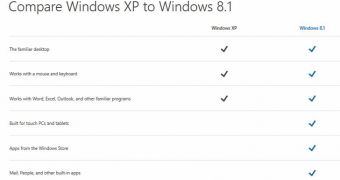Microsoft continues its efforts to move Windows XP users to Windows 8.1, especially because the company needs more users for its new modern platform, so the company today rolled out a comparison chart to explain that its new OS is much better than the 12-year-old product.
There is no doubt that Windows XP is no longer capable to cope with today’s technologies, especially because it was designed to work on old hardware and to offer compatibility with software launched more than 12 years ago, so Windows 8.1 is clearly a much better choice for users.
According to Microsoft’s comparison chart, both Windows XP and Windows 8.1 come with the familiar desktop, work with a mouse and keyboard and offer support for Word, Excel, Outlook, and other familiar programs.
But this is where Windows XP’s capabilities come to an end, with Windows 8.1 excelling in many other areas, as Microsoft tries to emphasize in its new chat.
Basically, Windows 8.1 has everything it needs to work on touch PCs and tablets, download apps from the Windows Store, keep your settings and apps on all your PCs and devices and boast faster startup times.
While it’s a bit weird that Microsoft first said that Windows 8.1 and Windows XP come with a familiar desktop and then explained that only the first has the possibility to work on touch PCs and tablets, Redmond clearly wants to move everyone to the OS version launched in October.
“Get a new touchscreen PC and you can still work with a mouse, keyboard, and the Windows desktop the way you always have. Use virtually any printer. Programs that work on Windows 7 work on Windows 8.1. All the basics, from startup times to security, are better than ever,” Microsoft says.
And although it’s pretty obvious that Windows 8.1 is a much better operating system for today’s technologies, not everyone is willing to abandon Windows XP and 29 percent of the desktop users are still running it.
That’s happening especially because an upgrade to Windows 8.1 also involves hardware improvements, so the overall process is much more expensive than you might be tempted to believe. Microsoft knows this very well, so the company is still struggling to bring more affordable devices to the market, including tablets and PCs that would retail for less than $250 (€180).
In order to convince PC makers to develop more affordable devices, Microsoft is offering major license price cuts for Windows 8.1 which would only be available for partners that device to launch tablets and PC below the $250 price tag.

 14 DAY TRIAL //
14 DAY TRIAL //